Get best WooCommerce Plugins > Instagram stands out among tons of social media platforms as…
How to Setup a Professional Email Address with Gmail and G Suite

After creating a website, the first thing every business owner needs is a professional email address with their business name in it.
A professional email address will help you win trust when dealing with other businesses and customers.
G Suite is Google’s productivity suite that allows you to use Gmail with your own professional email address. In this article, we will show you how to setup a professional custom branded email address with Gmail and G Suite.
What is a Professional Email Address?
A professional email address is the one that has your business name in it. For example, john@myphotostudio.com is a professional email address.
Email accounts on free email services like john.photographer@gmail.com are not good for business because they do not look professional. Your customers and other businesses will find a professional email address more trustworthy.
For a professional email address, you will need a domain name and a website. We have step by step guides on how to choose a domain name and how to quickly make a website.
If you already have a domain name and a website, then you are all set to have your own professional email address.
Why Use G Suite for Professional Branded Email Address?
You might be thinking why use G Suite when most WordPress hosting companies offer unlimited email accounts with your own domain name?
Email is one of the most important communication tool for business owners. If you miss an important email, then it can hurt your business.
Most web hosting email servers are unreliable, restrictive, isolated, and less secure. You wouldn’t even know if the email you sent was actually delivered.
This is where G Suite and Gmail comes in.
Gmail is the industry leader in email with 1.5 billion monthly active users. G Suite is Google’s productivity app suite for business owners which includes Gmail and is already used by over 4 million businesses and 80 million students / educators.
G Suite works with your own domain name, which allows you to use Gmail to create your professional branded email address.
Here are some of the benefits of using G Suite and Gmail for a professional email address:
- Professional business email address on your own domain.
- Gmail’s rock solid security and spam filters.
- 30 GB – Double the storage of a free Gmail Account.
- Manage email even when offline using Gmail app on mobile devices.
- Works anywhere web, mobile, tablet, you name it.
- Works great with Outlook and can even sync old Outlook accounts.
- Each user can have up to 30 email aliases.
- Use Google Calendar, Google Hangouts for chat, video, and voice calls on your own business email address.
- No advertisements and 24/7 professional support whenever you need help.
- Works seamlessly with your WordPress site.
- Most important of all, high deliverability, no delays, no ending up in spam folder.
Now that you know why using G Suite for professional emails is important, let’s take a look at how to set up a branded professional email address with G Suite.
Editor’s Note: We use G Suite for all of our professional email addresses and can honestly say it’s the best.
Setting up a Professional Email Address with Gmail (G Suite)
First you will need to signup for a G Suite account.
It costs around $5/month for each user. If you pay annually, then you get 2 months free ($50/year per user).
G Suite also offers a free 14-day trial, which allows you to test drive everything before you make up your mind. Basically its all the powerful features you’re used to of Gmail, Drive, Calendar, etc (but now it’s for your business).
Simply visit the G Suite website and click on the Get Started button for the plan you want to use.
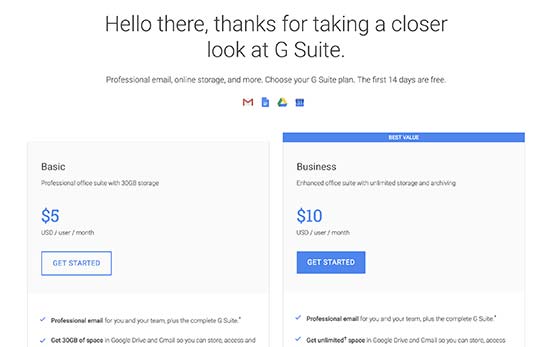
Next, you need to enter your business name, the number of employees, and the country where you are located. You can choose just yourself for 1 user account, or choose the number of employees.
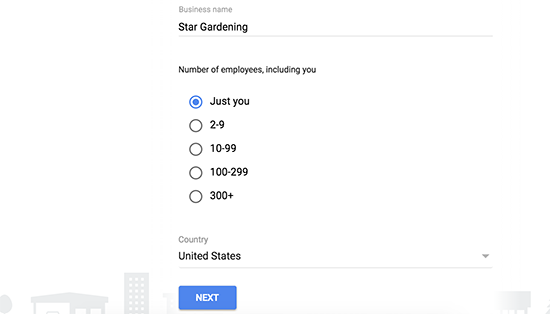
Click on the next button to continue.
On the next step, you will be asked to enter your personal contact information including name and email address.
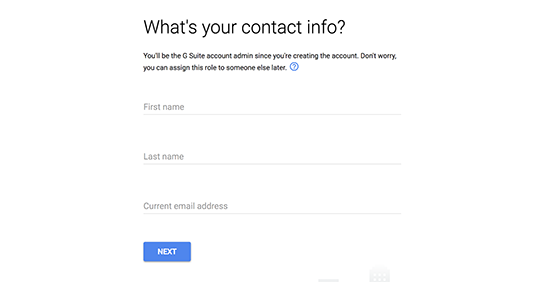
After that, you will be asked to choose a domain name. If you already have a domain name, then click on ‘Yes I have one I can use’. Otherwise, click on ‘No, I need one’ to register a domain name.
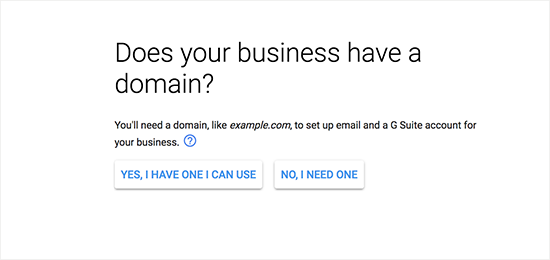
If you need to register a new domain name, then you will be charged separately for registering a new domain name (tip: here’s how to register a domain name for free).
If you are using an existing domain name, then you will need to verify ownership of the domain name. We’ll show you how to do that later in this article.
In the next step, you will be asked to create your G Suite user account by entering a username and password.
This username will also be your first professional email address, so you need to choose a username that you want to use as your professional email address.
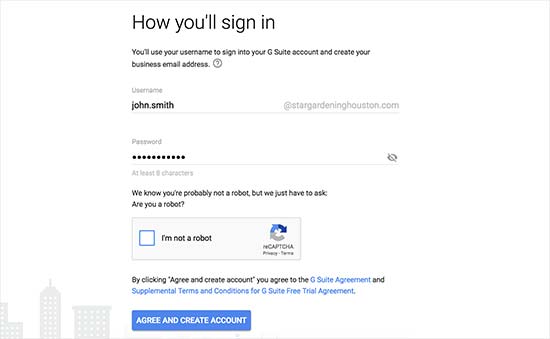
You have successfully created your G Suite account. You can now click on the ‘Go to Setup’ button
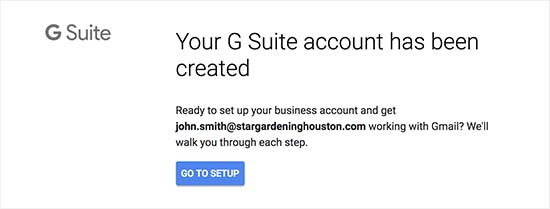
On the setup screen, you will be asked to add more people to your account. If you want to create more accounts for your employees or departments, then you can do that here.
You can also just click on ‘I have added all user email addresses’ and click on the next button.
Remember, you can always add more users to your account and create their email addresses later when needed.
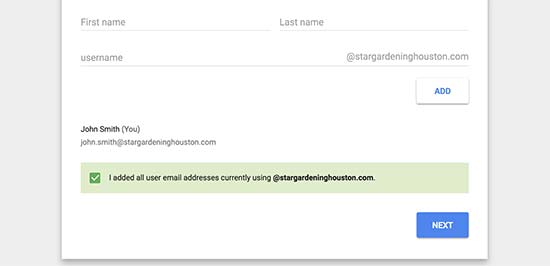
If you registered your domain name elsewhere, then you will now be asked to verify your ownership of the domain name.
After that you will see a HTML code snippet that you need to add to your website.
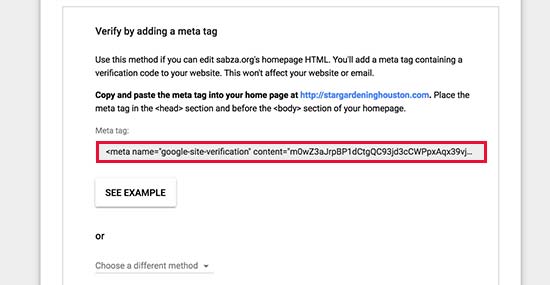
There are other ways to verify your website ownership as well. You can upload a HTML file to your website using an FTP client or file manager app in your hosting account dashboard.
If you don’t have a website, then you can use also use the MX Record method. You will see step by step instructions to do that once you choose this method.
For the sake of this tutorial, we are assuming that you already have a WordPress blog, and we will show you how to add the verification HTML code snippet in WordPress.
Switch to the WordPress admin area in a new browser tab to install and activate the Insert Headers and Footer plugin. For more details, see our step by step guide on how to install a WordPress plugin.
Upon activation, go to Settings » Insert Headers and Footer page and paste the HTML code you copied from G Suite under the ‘Scripts in Header’ section.
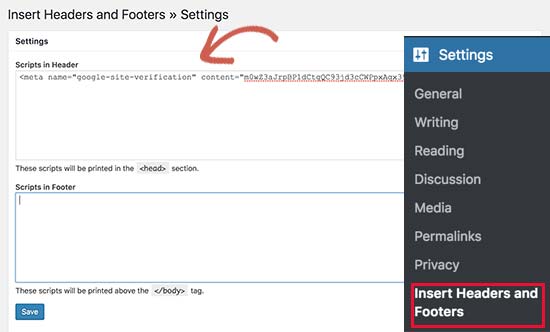
Don’t forget to click on the ‘Save’ button to store your settings.
Now switch back to your G Suite setup screen and click on the checkbox that says ‘I added the meta tag to my homepage’.
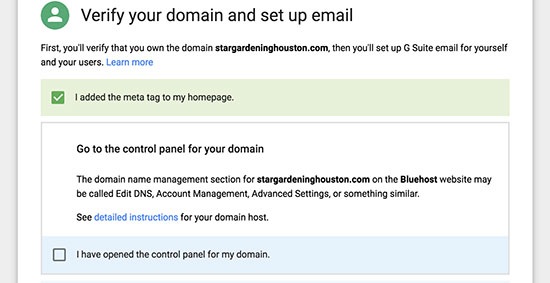
Next, you will be asked to enter MX record entries for your domain name.
Note: You only need to add MX records if you have an existing domain name and website. Users who registered their domain names via Google, don’t need to add MX records.
Since your domain name is not registered with Google, your emails will reach your domain name, but not to the Google servers.
You will need to set up the right MX records on your domain name settings, so Google’s servers can send and receive emails for your business.
To do that, you will need to login to your web hosting account, or your domain registrars account.
We will show you how to add MX records in Bluehost, but the basic concept is the same on all hosts and domain registrars. Basically, you will be looking for DNS settings under your domain name.
Login to your Bluehost hosting dashboard and click on ‘Domains’. On the next page, select your domain name and then click on the ‘Manage’ link next to DNS Zone Editor option.
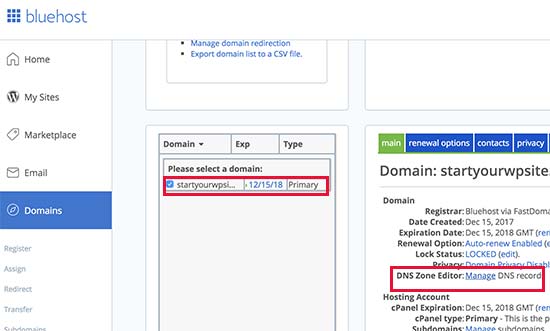
Bluehost will now open your DNS zone editor. You need to switch back to your G Suite setup screen and check the box that says ‘I have opened the control panel of my domain name’.
It will now show you the MX records that you need to enter. You will also see a link to the documentation which shows you how to add these records to dozens of hosting and domain services provider.
Here is how you will add this information to your Bluehost DNS settings:
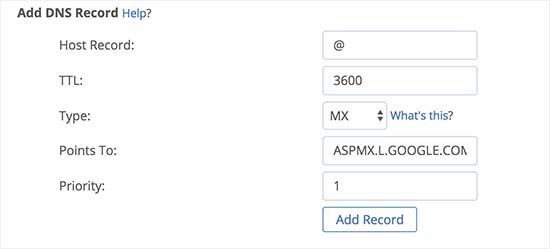
Click on ‘Add Record’ button to save it. After that, repeat the process to add all five lines as MX records.
Once you are finished, switch back to G Suite setup and check the box next to ‘I created the new MX records’.
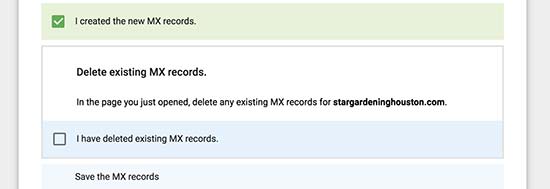
You will be asked to delete any existing MX records still pointing to your website hosting or domain name registrar.
To do this, you need to switch back to your DNS zone editor and scroll down to the MX records section. You will see the MX records you created earlier along with an older MX record still pointing to your website.
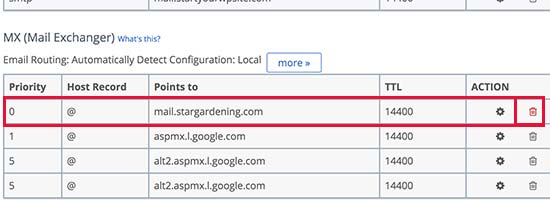
Click on the delete button next to the old MX record to delete it.
After that, switch back to the G Suite setup screen and check the box that says ‘I deleted existing MX records’.
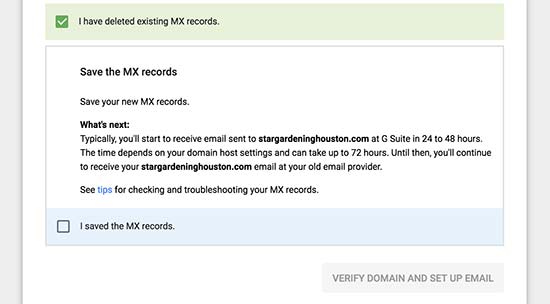
You will now be asked to save your MX records. For some providers, once you add MX records they are already saved, for others you may need to manually save MX records.
Once you have saved MX records, check the box that says ‘I have saved MX records’ in G Suite setup.
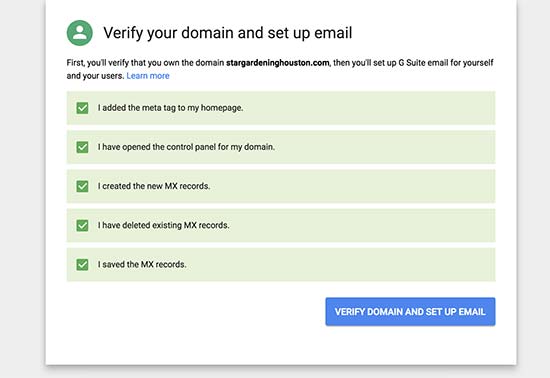
After that, you need to click on ‘Verify domain and setup email’ button to exit the setup wizard.
Using Your Professional Email with G Suite and Gmail
Your email account works like any other Gmail account. You can access it by visiting Gmail Website and sign in with your email address, e.g. john@yourdomain.com.
You can also manage your G Suite account by visiting the admin console.
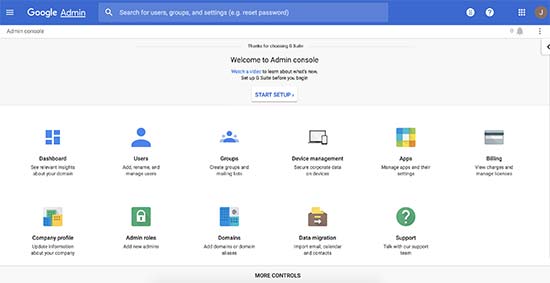
This is where you can add/remove new users to your domain name. Each of your users will have 30 GB storage and all the same features, but they will not have access to the admin console. You can remove those users at any time you want.
Troubleshooting G Suite Domain Setup
It is likely that your web host may not be using a dashboard like we have shown in the screenshots above.
G Suite has detailed documentation for many of the popular web hosting and domain registration service providers. Visit, set up MX records (Hosts specific steps) page and then locate your domain registrar or web host from the list.
If you do not find your service provider in the list, then you can ask them directly to help you setup G Suite for your domain name.
- Sale
Connect 365/7/24 Hourly Support
Original price was: $120.00.$99.00Current price is: $99.00. - Sale
Connect Auto-Pilot for WordPress Content Management
Original price was: $599.00.$499.00Current price is: $499.00. - Sale
%22%20transform%3D%22translate(1.8%201.8)%20scale(3.63281)%22%20fill-opacity%3D%22.5%22%3E%3Cpath%20fill%3D%22%23c2ffee%22%20d%3D%22M204.4%20130.6l1.2%2072-158%202.8-1.2-72z%22%2F%3E%3Cellipse%20fill%3D%22%23c4ffef%22%20cx%3D%22122%22%20cy%3D%2272%22%20rx%3D%2283%22%20ry%3D%2235%22%2F%3E%3Cellipse%20fill%3D%22%23beffea%22%20cx%3D%2265%22%20cy%3D%22126%22%20rx%3D%2235%22%20ry%3D%2256%22%2F%3E%3Cellipse%20fill%3D%22%2388ccb5%22%20rx%3D%221%22%20ry%3D%221%22%20transform%3D%22matrix(51.92988%20-137.38378%2059.61857%2022.5353%20255%20209.3)%22%2F%3E%3C%2Fg%3E%3C%2Fsvg%3E) Select options This product has multiple variants. The options may be chosen on the product page
Select options This product has multiple variants. The options may be chosen on the product pageConnect WordPress Maintenance Plans
$99.00 – $224.00






